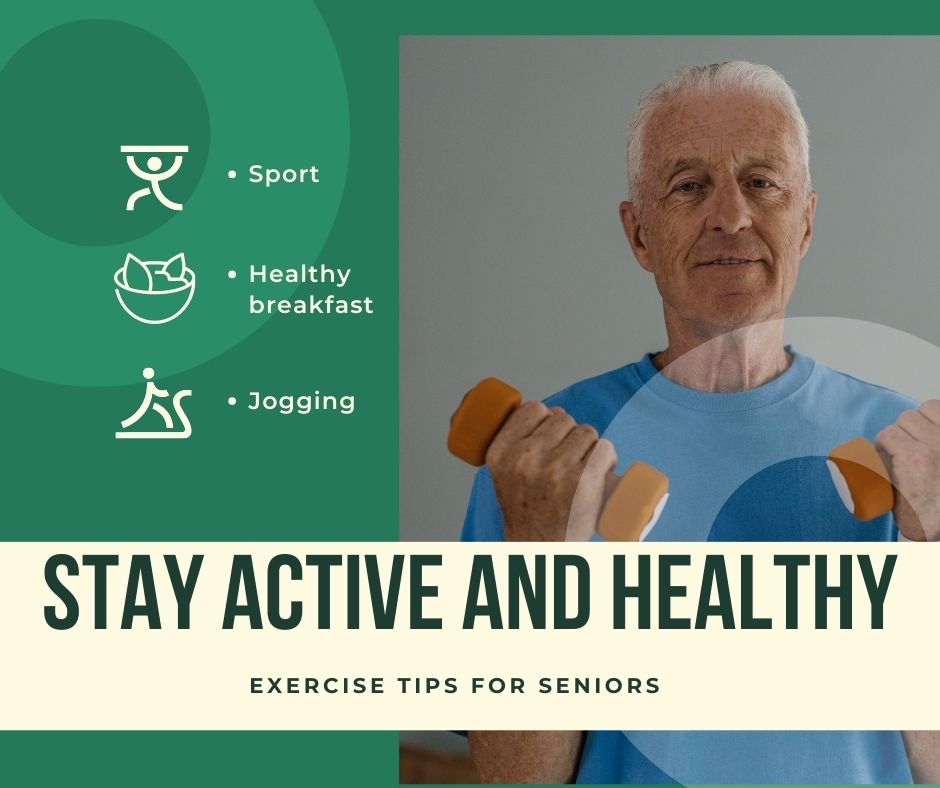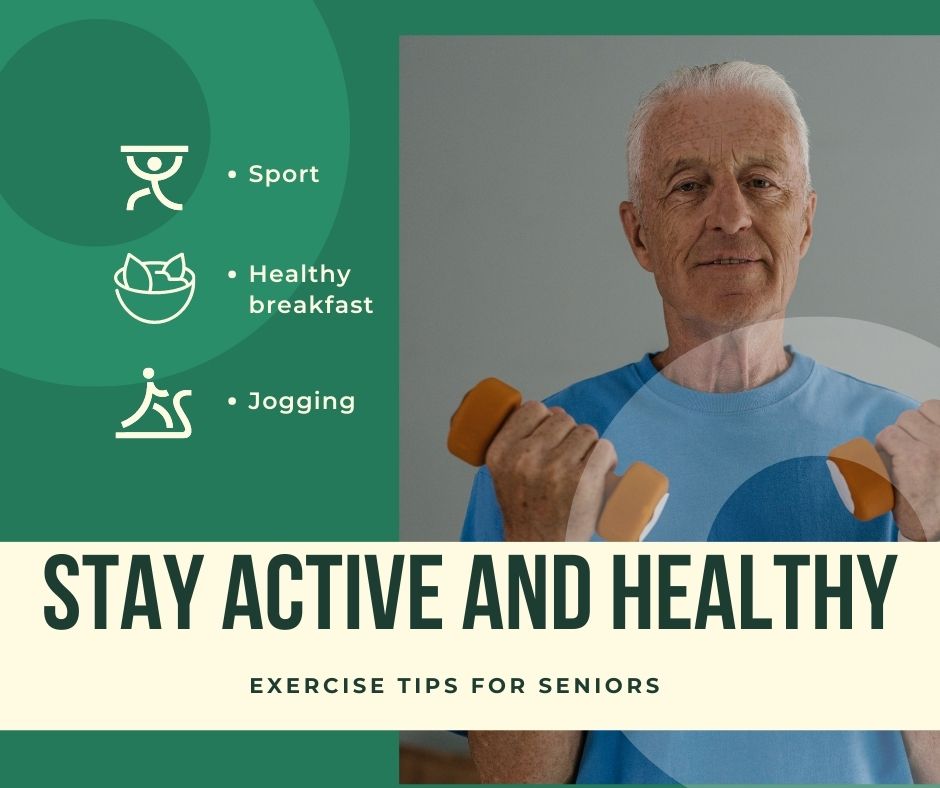Are you tired of feeling sluggish and out of shape? Do you long for the days when you had boundless energy and strength? Well, get ready to turn back the clock and reclaim your vitality!
In this article, we will share with you some amazing exercise tips specifically designed for seniors like yourself. These tips are guaranteed to help you stay active and healthy, no matter what your age or physical condition.
From tailoring exercises to your abilities to incorporating strength training into your routine, we’ve got all the information you need to start making positive changes today.
Plus, we’ll give you some valuable advice on staying motivated and consistent so that your new exercise regimen becomes a permanent part of your life.
So put on those sneakers, grab a water bottle, and let’s get moving towards a healthier, more energetic future!

Importance of Regular Physical Activity
You should make sure you’re getting regular physical activity to stay healthy and active as a senior. Engaging in regular exercise has numerous benefits for seniors, both physically and mentally.
First and foremost, it helps to maintain a healthy weight, which reduces the risk of developing chronic conditions such as heart disease, diabetes, and arthritis. Regular physical activity also improves cardiovascular health by strengthening the heart and improving blood circulation.
It can help improve balance and flexibility, reducing the risk of falls and injuries. Exercise is also known to boost mood by releasing endorphins, which can help alleviate symptoms of depression and anxiety.
It’s important to find activities that you enjoy and that suit your abilities. Start slowly if you haven’t been active recently, gradually increasing intensity over time. Walking is an excellent low-impact exercise that can be easily incorporated into your daily routine. Swimming or water aerobics are great options for those with joint pain or limited mobility. Strength training exercises using resistance bands or light weights can help maintain muscle mass and bone density.
By staying physically active as a senior, you not only enhance your overall health but also improve your quality of life. Now let’s explore how you can tailor exercise to your abilities without overexertion.
Tailoring Exercise to Your Abilities
When it comes to tailoring your exercise routine to your abilities, there are a few key considerations. First and foremost, it’s important to listen to your body and not push yourself too hard. Take breaks when needed and don’t compare your abilities to others. Remember, everyone is unique, and it’s important to honor your own limits.
If you have joint pain or mobility issues, low-impact activities such as walking, swimming, or cycling may be more suitable for you. These exercises are gentle on the joints while still providing cardiovascular benefits. Additionally, if balance is a concern, incorporating exercises that focus on improving stability, like yoga or tai chi, can be beneficial. These activities can help increase flexibility and build core strength, which are essential for maintaining balance and preventing falls.
Incorporating strength training into your routine can also be advantageous. This type of exercise helps build muscle mass and bone density, reducing the risk of fractures and osteoporosis. Consider using resistance bands or light weights for added resistance during exercises like bicep curls or squats.
By tailoring your exercise routine to suit your abilities and incorporating strength training when appropriate, you can continue to stay active and healthy as a senior.
Incorporating Strength Training into Your Routine
Enhance your workout routine by incorporating strength training exercises to promote muscle growth and improve bone density. Strength training is an important component of any exercise routine, especially for seniors. It helps maintain and increase muscle mass, which can help with everyday activities like carrying groceries or getting up from a chair.
Additionally, strength training can improve balance and stability, reducing the risk of falls.
There are many different types of strength training exercises that you can incorporate into your routine. One option is resistance training using weights or resistance bands. This type of exercise works by creating resistance against your muscles, which helps them get stronger over time.
Another option is bodyweight exercises such as push-ups or squats, which use your own body weight as resistance.
When starting a strength training program, it’s important to start slowly and gradually increase the intensity and duration of your workouts. Don’t forget to warm up before exercising and cool down afterwards to prevent injury.
Incorporating strength training into your routine will not only help you build muscle and improve bone density but also prepare you for the next section about cardiovascular exercises for seniors without skipping a beat.
Cardiovascular Exercises for Seniors
Jumpstart your fitness routine with invigorating cardiovascular exercises that will get your heart pumping and blood flowing. Engaging in regular cardio workouts can improve your overall health and well-being as a senior. Not only do these exercises strengthen your heart and lungs, but they also help maintain a healthy weight, reduce the risk of chronic diseases, and boost your mood.
There are various low-impact cardiovascular exercises suitable for seniors. Walking is an excellent choice because it is easy on the joints and can be done outdoors or on a treadmill. Swimming or water aerobics are also great options as they provide resistance without putting stress on your joints. Cycling, either outdoors or using a stationary bike, is another effective way to get your heart rate up.
Remember to start slowly and gradually increase the intensity of your workouts over time. Aim for at least 150 minutes of moderate-intensity cardio exercise per week, such as brisk walking or cycling. If you have any existing health conditions, consult with your doctor before starting a new exercise program.
By incorporating cardiovascular exercises into your routine, you’ll not only improve your physical health but also increase your energy levels and enhance mental clarity. These benefits will help you stay motivated and consistent in maintaining an active lifestyle.
Tips for Staying Motivated and Consistent
Maintaining a consistent fitness routine is like fueling the fire within, keeping it burning bright and propelling you towards your health goals. Staying motivated may seem challenging at times, but with some tips and tricks, you can make exercise a regular part of your life.
Firstly, set realistic goals that are achievable for you. Start small and gradually increase the intensity and duration of your workouts. This will help you stay motivated by giving you a sense of accomplishment as you reach each milestone.
Secondly, find an exercise buddy or join a group class. Exercising with others not only adds fun and social interaction to your routine but also provides accountability. Knowing that someone is expecting you to show up can be a great motivator.
Additionally, mix up your workout routine to keep things interesting. Trying new activities or varying the intensity of your exercises can prevent boredom and plateaus in your progress.
Lastly, reward yourself for staying consistent with your fitness routine. Treat yourself to something enjoyable after completing a certain number of workouts or reaching a specific goal. This positive reinforcement can help motivate you to keep going.
Remember, staying motivated and consistent with exercise is essential for maintaining good health as a senior. By following these tips and finding what works best for you, exercising regularly will become an enjoyable habit that contributes to your overall well-being.
Conclusion
Overall, staying active and healthy is crucial for seniors. Regular physical activity not only improves physical health but also boosts mental well-being. By tailoring exercises to your abilities, incorporating strength training, and engaging in cardiovascular exercises, you can maintain a strong and resilient body.
Remember, consistency is key! Did you know that participating in regular exercise can reduce the risk of developing chronic diseases by up to 50%? So lace up your sneakers, hit the gym or go for a walk, and enjoy the benefits of an active lifestyle!
